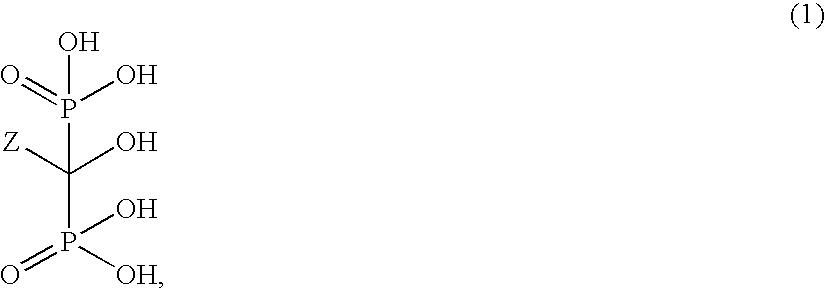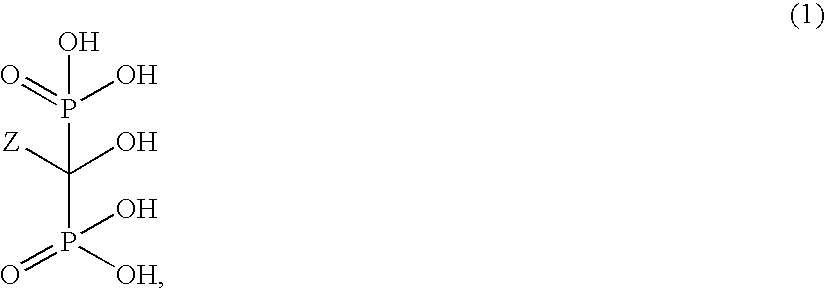Process for making 1-hydroxyalkylidene-1,1-biphosphonic acids
a technology of hydroxyalkylidene and phosphonic acid, which is applied in the field of process for making 1-hydroxyalkylidene-1,1-biphosphonic acid, can solve the problems of complex work-up, poor stirring of reaction mixture, and complicated reaction mixture, and achieves simple and effective process, high purity and commercial scale
- Summary
- Abstract
- Description
- Claims
- Application Information
AI Technical Summary
Benefits of technology
Problems solved by technology
Method used
Image
Examples
example 1
Ibandronic Acid in Formaldehyde Diethyl Acetal
[0037]3 g of (3-methyl-pentyl-amino)propionic acid hydrochloride 4.46 g of H3PO3 and 9 ml of ethylal (formaldehyde diethyl acetal) was stirred at 40° C. for 30 minutes. 4.75 ml of PCl3 was added to the reaction mixture during 5 minutes. Reaction mixture was heated to 65° C. and heating continued 5 hours. Then 24 ml of water was added in 10 minutes. Reaction mixture was refluxed at 95° C. of bath temperature for 18 hours. The mixture was cooled to 20° C. and filtered through kieselguhr. The filtered cake was washed with 2 ml of water. The filtrate was neutralized with 5-6 ml of 50% aqueous sodium hydroxide to pH 4.2-4.5. 150 ml of ethanol was added and the mixture was stirred in ice bath for 4 hours. The precipitated crystals were filtered off and washed with 10 ml of ethanol, 10 ml of acetone:water=5:2, 10 ml of acetone, and 10 ml of ether. The crystals were dried at 50° C. Yield: 4.51 g of ibandronic acid sodium salt hydrate.
example 2
Ibandronic Acid in Formaldehyde Diethyl Acetal
[0038]3 g of (3-methyl-pentyl-amino)propionic acid hydrochloride 4.46 g of H3PO3 and 9 ml of ethylal (formaldehyde diethyl acetal) were stirred at room temperature for 30 minutes. Then 4.75 ml of PCl3 was added during 15 minutes at temperature 22-40° C. The mixture was stirred at 58° C. for 4 hours. Then 24 ml of water was added dropwise and the reaction mixture was stirred at 95° C. (in bath) for 18 hours. Then the mixture was cooled to 20° C. and neutralized with 50% aqueous sodium hydroxide to pH 4.2-4.5 (6 ml). Then 30 ml of ethanol was added and the solution was stirred for 4 hours at 15-20° C. Precipitated crystals were filtered off and washed with 60 ml of mixture (acetone:water=5:2). The crystals were dried at 50° C. Yield: 3.57 g of ibandronic acid sodium salt hydrate.
example 3
Ibandronic Acid in Formaldehyde Dibutyl Acetal
[0039]3 g of (3-methyl-pentyl-amino)propionic acid hydrochloride 4.46 g of H3PO3 and 9 ml of butylal (Dibutoxymethane) was stirred at 40° C. for 30 minutes. 4.75 ml of PCl3 was added to the reaction mixture during 5 minutes. Reaction mixture was heated to 65° C. for 5 hours. Then 24 ml of water was dropped for 10 minutes. Reaction mixture was refluxed at 95° C. (in bath) for 18 hours. Then mixture was cooled to 20° C. and neutralized with 7-8 ml of 50% aqueous sodium hydroxide to pH 4.2-4.5. 150 ml of ethanol was added and the mixture was stirred in ice bath for 4 hours. The precipitated crystals were filtered off and washed with 10 ml of ethanol, 10 ml of acetone:water=5:2, 10 ml of acetone, and 10 ml of ether. The crystals were dried at 50° C. Yield: 7.94 g of ibandronic acid sodium salt hydrate.
PUM
| Property | Measurement | Unit |
|---|---|---|
| temperature | aaaaa | aaaaa |
| bath temperature | aaaaa | aaaaa |
| temperature | aaaaa | aaaaa |
Abstract
Description
Claims
Application Information
 Login to View More
Login to View More - R&D
- Intellectual Property
- Life Sciences
- Materials
- Tech Scout
- Unparalleled Data Quality
- Higher Quality Content
- 60% Fewer Hallucinations
Browse by: Latest US Patents, China's latest patents, Technical Efficacy Thesaurus, Application Domain, Technology Topic, Popular Technical Reports.
© 2025 PatSnap. All rights reserved.Legal|Privacy policy|Modern Slavery Act Transparency Statement|Sitemap|About US| Contact US: help@patsnap.com



